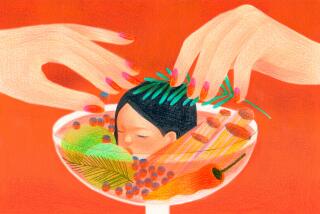Coke Directs Caffeine-Free Soda Ads at Aging Boomers
- Share via
Coca-Cola Corp. is trying to revive sales of caffeine-free Diet Coke by pitching it to the over-40 caffeine generation.
It is the first time that Coke has deviated from a formula that celebrates youth to target an older audience. The move, closely watched in the beverage industry, comes as diet colas are under assault from New Age beverages, iced teas and bottled water.
The strategy, kicked off earlier this year, will get its first big test during the important summer selling season, which starts this Memorial Day weekend.
“It is a flat product category and cola companies have to find new ways to sell,” said New York beverage industry consultant Tom Pirko. Boomers, as they age, “are an evolving market with certain needs,” making them more receptive than twentysomethings to a product without sugar or caffeine, he said.
In its first TV commercials for the brand in years, Coke portrays the fortysomethings as youthful, clever and hip. In one spot, a woman boxer clobbers a parade of younger male challengers. Her secret: a caffeine-free Diet Coke up her glove. The ad closes with the can-do slogan, “No limits.”
“We want to reflect the vitality and humor of people at this stage of life,” said Nancy Gibson, worldwide director for Diet Coke.
The slogan is also a play on Coke’s hopes for the product: that people will drink it any time, not simply during the evening when die-hard cola drinkers want to avoid caffeine. TV spots for caffeine-free Diet Coke are set in the daytime--a sort of serving suggestion for viewers.
Coke is also making the brand more available in vending machines, particularly those in supermarkets and drugstores--locations where consumers are likely to pick up a soft drink during the day.
“There are only a few things you can do to increase sales,” said Jesse Meyers, publisher of Beverage Digest, a trade journal. “You can encourage more product use. You can make it more available. Coke is doing all those things.”
Caffeine-free colas were first introduced in the early 1980s to boost soft drink consumption at night. Sales grew until 1992, when consumers looking for a new taste experience switched to New Age beverages, such as those made by Snapple Beverage Co.
Coke’s caffeine-free brand took a heavy beating. It’s share of the soft drink market fell to 2% in 1994 from 2.4% in 1990, according to Beverage Digest. Each tenth of a percentage point represents $500 million in retail sales.
Pepsi’s caffeine-free diet cola also suffered, according to the Maxwell Report. Its share of the soft drink market fell to 1.2% in 1994 from 1.4% in 1990.
The competition from alternative beverages came as consumers became less concerned about caffeine and sugar. A survey by the market research firm Find SVP shows that the percentage of consumers worried about caffeine and sugar consumption has steadily dropped since sales of caffeine-free diet colas peaked in 1991. The survey shows consumers have shifted their concern to fat.
As the important summer selling begins, soft drink makers are encountering a “diet area that is weaker now than it has been for some time,” said industry analyst Meyers.
Soft drink marketers, while celebrating youth in their ads, have typically avoided targeting a specific age group. That is because beverage companies don’t want to alienate any consumers from what is a mass-market product.
But Coke said its research shows that 60% of drinkers of its caffeine-free diet cola are aging baby boomers. Though they belong to what Gibson calls the “caffeine generation,” they represent the best chance for boosting sales. The over-40 crowd, by contrast, makes up only 35% of Diet Coke drinkers.
“They have their caffeine in the morning and tend to moderate their caffeine over the course of the day,” Gibson said.
The “No limits” slogan captures the typical boomer’s self-image, says Peter Stisser, vice president of Roper Starch Worldwide, a market research firm. In another spot for caffeine-free Diet Coke created by Paris-based Publicis Conseil, an older man juggles cans of the soft drink and steals away a young woman from a body builder on Venice Beach.
“The maturing baby boomer is not worried about youth or physical prowess. They don’t see their 40s or 50s as a barrier,” he said.
Archrival Pepsi, meanwhile, is sticking with its more traditional approach. It has no separate TV ads for caffeine-free diet cola. It is marketing the Pepsi brands to a broad audience under the slogan “Nothing else is a Pepsi.”
Pepsi representative Amy Sherwood said the company believes consumers “interpret the Pepsi message in a way that is relevant to them, whether they drink Pepsi or Diet Pepsi.”
The soft drink giants both say their strategies appear to be working. Coke’s Gibson said sales of caffeine-free Diet Coke are up so far this year, but she would not provide figures.
Pepsi said figures from Information Resources, a market tracking firm, indicates its sales volume is up in supermarkets. Pepsi said that in April, sales of Diet Pepsi, including caffeine-free, climbed 6.6%. Sales of the Diet Coke brands grew 2.3%.
However, the figures offer only a partial look at the situation, since supermarkets account for about 40% of U.S. soft drink sales volume.
More to Read
Inside the business of entertainment
The Wide Shot brings you news, analysis and insights on everything from streaming wars to production — and what it all means for the future.
You may occasionally receive promotional content from the Los Angeles Times.










